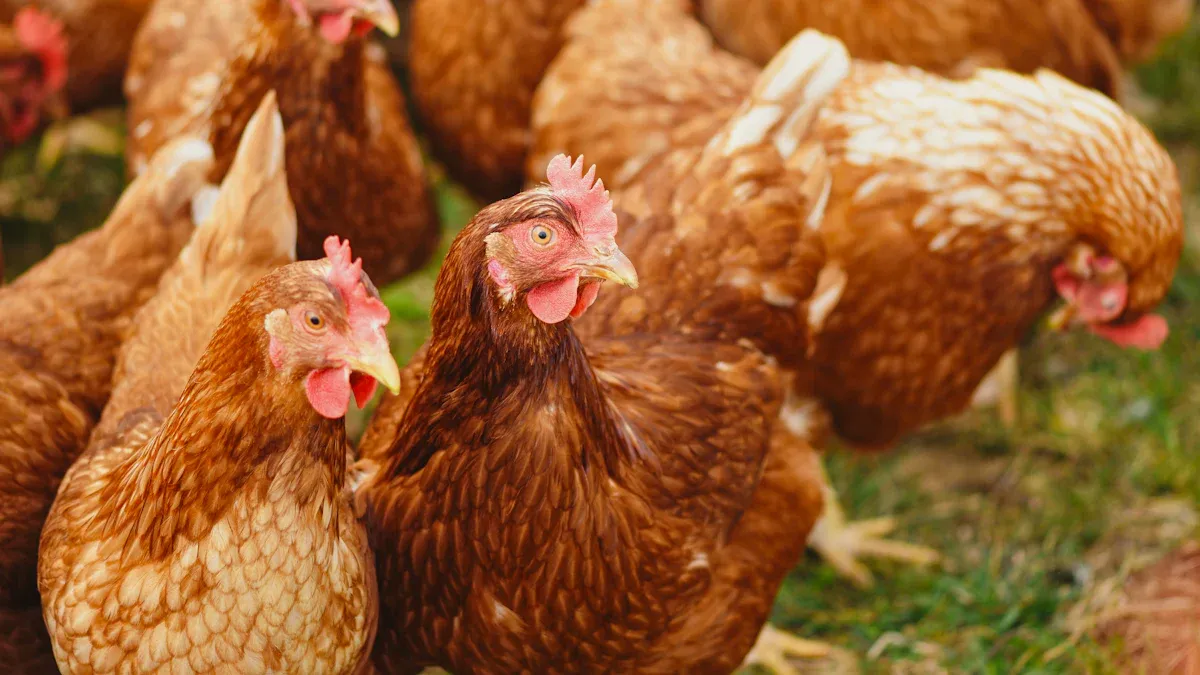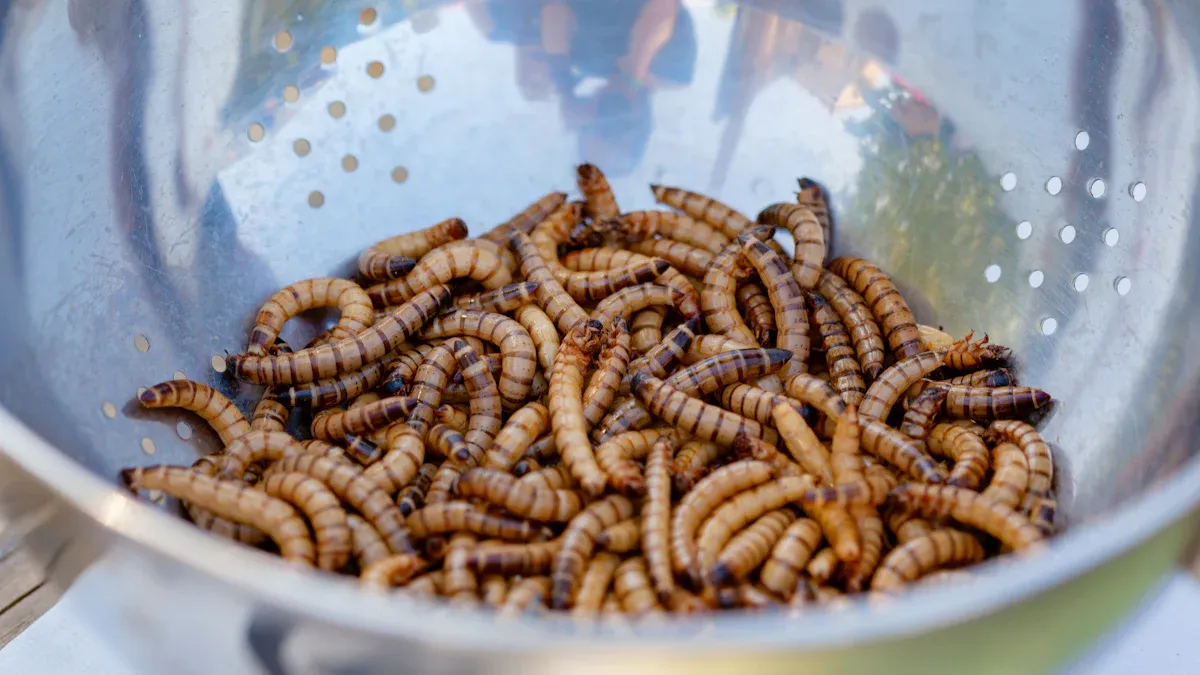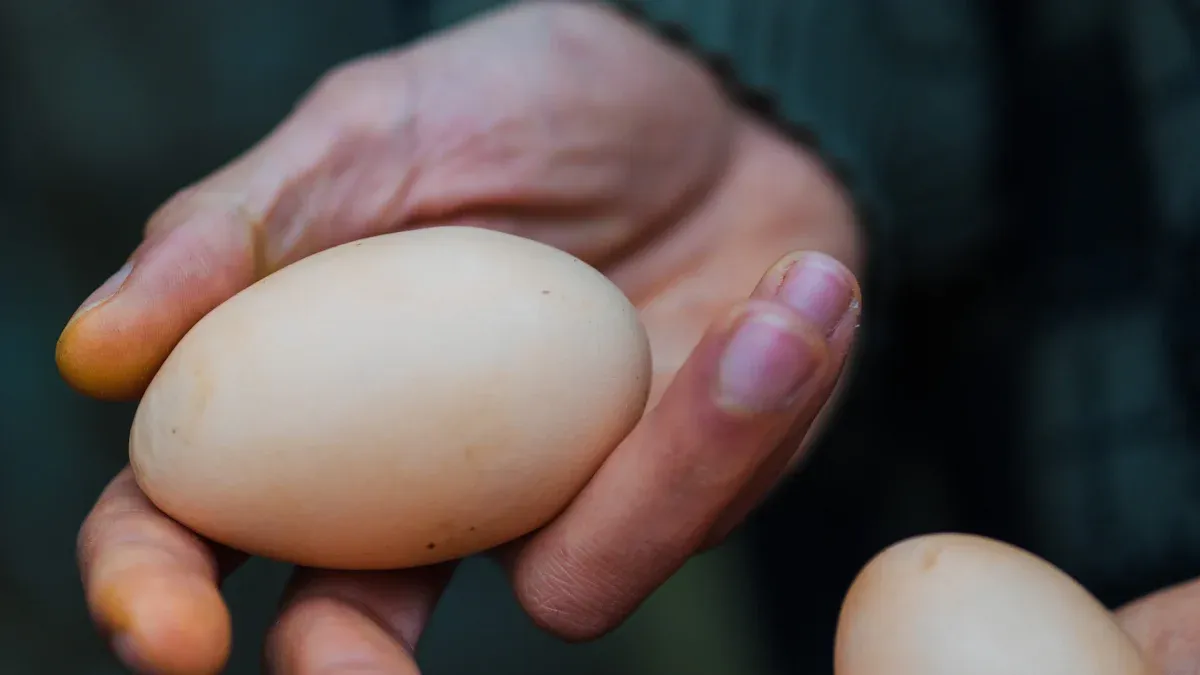
Feeding Mealworms to Chickens gives them a rich source of protein and vital nutrients. Recent research shows that adding up to 7.5% dried mealworms to their diet makes eggshells thicker and stronger. The table below compares the nutritional value of mealworms to other feed options.
| Nutrient/Aspect | Mealworm Content/Value | Comparison/Notes |
|---|---|---|
| Protein | 13.68–22.32 g per 100 g edible portion | Higher nutritional value than beef and chicken |
| Fat | 8.90–19.94 g per 100 g edible portion | Contains considerable polyunsaturated fatty acids |
| Essential Amino Acids | Present in considerable amounts | Comparable nutritional balance to conventional meats |
| Minerals | Zinc, Magnesium (high), Calcium (low) | Calcium can be improved with enriched diets |
| Vitamins | Niacin, Pyridoxine, Riboflavin, Folate, Vitamin B12 | Significant micronutrient sources |
| Feed Replacement in Aquaculture | Up to 25% replacement without yield loss | Higher replacement negatively affects yields |
Key Takeaways
- Feeding mealworms to chickens boosts protein and calcium intake, which helps produce stronger, thicker eggshells and supports healthy egg production.
- Offer mealworms as treats two to three times a week, keeping them under 10% of the daily diet to maintain balance and avoid digestive issues.
- Raising or feeding mealworms improves chicken health, encourages natural behaviors, and can make caring for your flock more enjoyable and sustainable.
Feeding Mealworms to Chickens: How Mealworms Improve Eggshell Strength
Protein and Calcium for Eggshell Formation
Chickens need both protein and calcium to form strong eggshells. Mealworms provide a rich source of protein, which helps build the eggshell’s inner matrix. They also contain calcium, an essential mineral for shell strength. Laboratory findings show that mealworms have a high protein content of about 51% and a calcium content of 5.23 grams per kilogram. These nutrients support the mineralization process that makes eggshells hard and durable.
| Nutrient/Component | Mealworms Value | Role in Eggshell Formation |
|---|---|---|
| Crude Protein (CP) | 51.02% | Builds the eggshell matrix and supports overall nutrition |
| Calcium (Ca) | 5.23 g/kg | Essential for shell strength and mineralization |
| Ash Content | 5.7% | Provides minerals for shell and bone development |
| Methionine | 2.3 g/100g | Important for poultry feed formulation |
Tip: Chickens need access to grit when eating mealworms. Grit helps them digest the mealworm’s hard exoskeleton and absorb nutrients better.
Although some studies on other insect meals, like black soldier fly larvae, show improved eggshell strength, direct research on mealworms and eggshell thickness is limited. However, the high protein and calcium content in mealworms suggests they can play a helpful role in supporting eggshell formation.
How Mealworms Support Healthy Egg Production
Feeding Mealworms to Chickens can improve their overall health, which leads to better egg production. Mealworms are packed with protein, fats, fiber, vitamins, and minerals. These nutrients help chickens grow, regrow feathers during molting, and absorb calcium more efficiently. Healthier hens tend to lay eggs more consistently and with better quality.
- Mealworms support feather regrowth during molting.
- They provide energy and nutrients for daily egg laying.
- Chickens that eat mealworms often produce eggs with thicker shells and richer yolks.
Scientific studies show that adding small amounts of mealworm meal (about 2.5% to 5%) to chicken diets improves growth, health, and feed conversion. These improvements can lead to more efficient egg production. Hens with better health and nutrition lay eggs more regularly and with stronger shells.
Other Benefits of Mealworms for Chickens
Mealworms offer many advantages beyond just eggshell strength. Chickens enjoy foraging for mealworms, which keeps them active and engaged. This natural behavior reduces boredom and stress in the flock.
| Parameter | Conventional Diet | Mealworm Diet (2.5-6%) |
|---|---|---|
| Body Weight Gain (g) | ~1322 | ~1423 |
| Feed Conversion Ratio | 1.88 | 1.75 |
| Egg Production Increase | Baseline | >5% increase |
| Dressing Percentage | Baseline | Increased |
- Mealworms improve gut health and nutrient absorption.
- They boost the immune system, making chickens more resistant to disease.
- Chickens show more natural behaviors, such as foraging and wing flapping, when mealworms are part of their diet.
Note: Feeding Mealworms to Chickens can also be a fun way to train your flock. Many keepers use mealworms as a treat to encourage chickens to come when called.
Mealworms provide a nutritious supplement that supports not only eggshell strength but also the overall well-being and happiness of your chickens.
Feeding Mealworms to Chickens: Safe and Practical Steps

Recommended Amounts and Frequency
Chickens benefit most from mealworms when owners follow proper feeding guidelines. Studies show that giving each chicken less than 10 mealworms at a time helps increase protein intake without upsetting their balanced diet. Owners should offer mealworms two to three times per week, not every day. This schedule keeps the diet balanced and prevents overfeeding. Mealworms should make up no more than 10% of a chicken’s daily food intake. Including up to 7.5% insect meal in the diet can improve eggshell strength and yolk color. Research also shows that moderate supplementation as treats, rather than as a main feed, supports health and egg quality. Feeding Mealworms to Chickens in this way helps maintain strong eggshells and healthy birds.
Tip: Too many mealworms can disrupt gut bacteria. Feed them as treats a few times a week for best results.
How to Feed Mealworms to Your Flock
Owners can use mealworms as a high-protein treat to boost feather growth and overall vitality. Feeding at consistent times, such as dawn or late afternoon, supports chicken health and reduces stress. Establishing a routine feeding schedule mimics natural foraging and keeps chickens active. Many keepers shake a container of mealworms while calling their chickens. This creates a positive association and makes it easier to gather the flock. Some use a unique whistle or phrase only when treats are available. Training sessions work best when kept short, about five to seven minutes. Chickens learn quickly when rewarded with mealworms right after performing a desired behavior.
- Use dried mealworms as treats to attract chickens.
- Shake a container and call the flock to create a routine.
- Practice daily during morning feedings for best results.
- Try clicker training by pairing a click sound with a mealworm reward.
Mealworms can also serve as a breakfast supplement or as an energy boost for sick or weak chickens. Owners often feed live mealworms to ill birds until they have eaten enough, then allow them to rest or rejoin the flock.
Sourcing and Raising Mealworms at Home
Many chicken keepers choose to raise mealworms at home. This method offers a cost-effective and sustainable way to provide fresh protein. Mealworms thrive in ventilated plastic bins with smooth sides to prevent escapes. Owners use oatmeal or chicken feed as bedding and food. Fresh vegetables like carrots or potatoes supply moisture and should be replaced regularly to avoid mold. The ideal temperature for raising mealworms is between 70°F and 80°F in a dark place. Regular cleaning prevents overcrowding, mold, and waste buildup.
Raising mealworms at home provides several benefits:
- High protein content supports molting, feather growth, and egg production.
- Mealworms offer essential fats and nutrients.
- Chickens enjoy foraging for live mealworms, which enriches their environment.
- Home production reduces reliance on commercial feeds and supports sustainable chicken keeping.
Note: Prevent escapes by using containers with tight-fitting lids and smooth walls. Avoid overcrowding to keep mealworms healthy and growing.
Common Concerns and Safety Tips
Some chicken owners worry about the safety of Feeding Mealworms to Chickens. Studies show that including 2% to 5% mealworm meal in laying hens’ diets does not harm gut health, liver function, or microbial stability. Researchers found no harmful pathogens, such as Salmonella or E. coli, in tested feed samples. Mycotoxin levels remained well below harmful limits. However, higher inclusion rates (10-15%) can disrupt gut bacteria and mucin balance. Owners should keep mealworm treats at or below 5% of the total diet to avoid these issues.
- Always store mealworms in clean, dry containers.
- Provide chickens with grit to help digest mealworm exoskeletons.
- Offer fresh water, especially when feeding dried mealworms.
- Clean up uneaten mealworms to prevent attracting pests.
Feeding Mealworms to Chickens in moderation, following these safety tips, ensures a healthy and productive flock.
Mealworms give chickens extra protein and nutrients. Flock owners see stronger eggshells and healthier birds.
- Feed mealworms in moderation with a balanced diet.
Try mealworms as a supplement. Chickens may lay better eggs and show more energy.
FAQ
Can chickens eat mealworms every day?
Chickens should not eat mealworms daily. Owners should offer mealworms as a treat two or three times a week for best health and egg quality.
Do mealworms replace regular chicken feed?
Mealworms do not replace regular feed. Chickens need a balanced diet with grains, vegetables, and grit. Mealworms work best as a protein-rich supplement.
Are dried or live mealworms better for chickens?
Both dried and live mealworms provide protein. Live mealworms encourage natural foraging. Dried mealworms offer convenience and longer storage. Owners can choose based on their flock’s needs.
Tip: Always provide fresh water when feeding dried mealworms.



